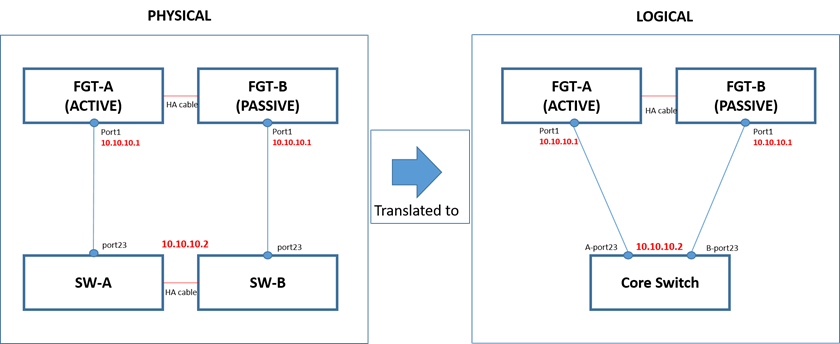- Forums
- Knowledge Base
- Customer Service
- FortiGate
- FortiClient
- FortiAP
- FortiAnalyzer
- FortiADC
- FortiAuthenticator
- FortiBridge
- FortiCache
- FortiCarrier
- FortiCASB
- FortiConnect
- FortiConverter
- FortiCNP
- FortiDAST
- FortiDDoS
- FortiDB
- FortiDNS
- FortiDeceptor
- FortiDevSec
- FortiDirector
- FortiEDR
- FortiExtender
- FortiGate Cloud
- FortiGuard
- FortiHypervisor
- FortiInsight
- FortiIsolator
- FortiMail
- FortiManager
- FortiMonitor
- FortiNAC
- FortiNAC-F
- FortiNDR (on-premise)
- FortiNDRCloud
- FortiPAM
- FortiPortal
- FortiProxy
- FortiRecon
- FortiRecorder
- FortiSandbox
- FortiSASE
- FortiScan
- FortiSIEM
- FortiSOAR
- FortiSwitch
- FortiTester
- FortiToken
- FortiVoice
- FortiWAN
- FortiWeb
- Wireless Controller
- RMA Information and Announcements
- FortiCloud Products
- ZTNA
- 4D Documents
- Customer Service
- Community Groups
- Blogs
- Fortinet Community
- Knowledge Base
- FortiGate
- Technical Tip: High Availability basic deployment ...
- Subscribe to RSS Feed
- Mark as New
- Mark as Read
- Bookmark
- Subscribe
- Printer Friendly Page
- Report Inappropriate Content
Created on
01-07-2020
12:18 AM
Edited on
02-05-2024
01:20 AM
By
![]() Anthony_E
Anthony_E
Description
This article explains Active-Passive High Availability scenario.
Scope
Any supported version of FortiGate, High Availability.
Solution
In the following scenarios, FortiGate is connected to two switches without LACP and with LACP (802.3ad) design.
Any HA deployment is highly dependent on the network side.
The following scenarios explain common best practices for HA network design.
Scenario 1: Without LACP.

- One cable(port23) from SW-B connects to FGT-B(port1).
Core switch: 10.10.10.2
SW-A(port23) to FGT-A(port1) set as VLAN100
SW-B(port23) to FGT-B(port1) set as VLAN100
From a core switch perspective, 10.10.10.1 (FortiGate) is reachable on VLAN100.
The core switch(SW-A & SW-B) may send traffic to both FGT-A and FGT-B at the same time due to the same VLAN100.

LACP Group B = Port23 & port24 of SW-B. This group connect to FGT-B port1&port2.
The Fortinet Security Fabric brings together the concepts of convergence and consolidation to provide comprehensive cybersecurity protection for all users, devices, and applications and across all network edges.
Copyright 2024 Fortinet, Inc. All Rights Reserved.